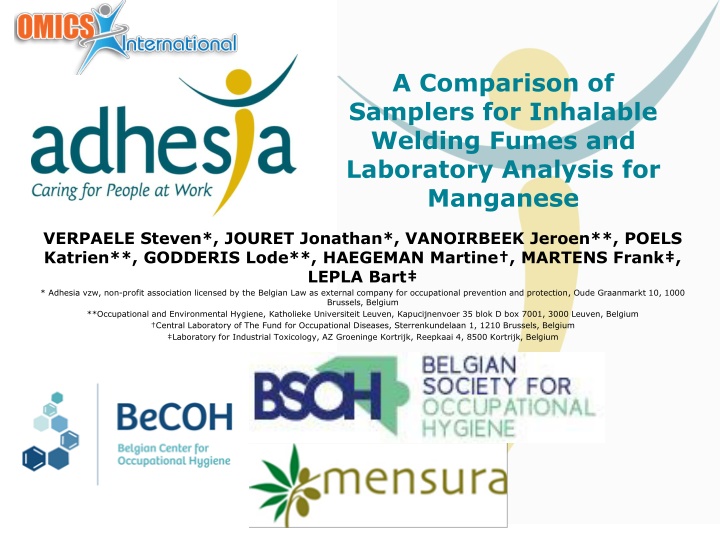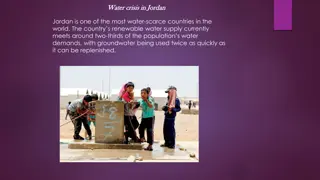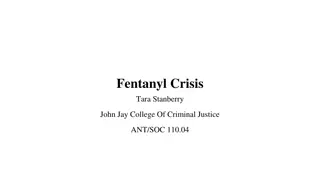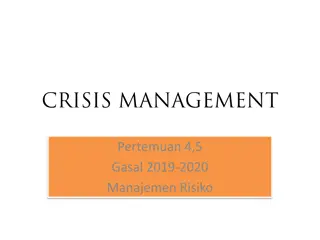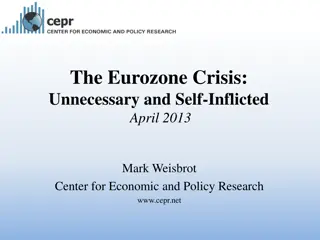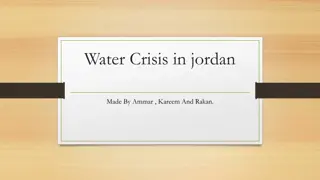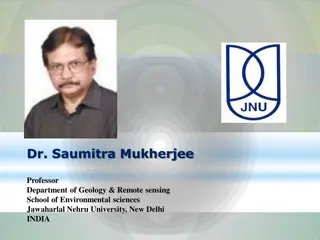Analysis of Water Crisis and Industry Impacts
The root causes and effects of the water scarcity crisis on various industries, including food, agriculture, and technology. Assessing the critical need for fresh water and the challenges posed by pollution and climate change."
Download Presentation

Please find below an Image/Link to download the presentation.
The content on the website is provided AS IS for your information and personal use only. It may not be sold, licensed, or shared on other websites without obtaining consent from the author.If you encounter any issues during the download, it is possible that the publisher has removed the file from their server.
You are allowed to download the files provided on this website for personal or commercial use, subject to the condition that they are used lawfully. All files are the property of their respective owners.
The content on the website is provided AS IS for your information and personal use only. It may not be sold, licensed, or shared on other websites without obtaining consent from the author.
E N D
Presentation Transcript
A Comparison of Samplers for Inhalable Welding Fumes and Laboratory Analysis for Manganese VERPAELE Steven*, JOURET Jonathan*, VANOIRBEEK Jeroen**, POELS Katrien**, GODDERIS Lode**, HAEGEMAN Martine , MARTENS Frank , LEPLA Bart * Adhesia vzw, non-profit association licensed by the Belgian Law as external company for occupational prevention and protection, Oude Graanmarkt 10, 1000 Brussels, Belgium **Occupational and Environmental Hygiene, Katholieke Universiteit Leuven, Kapucijnenvoer 35 blok D box 7001, 3000 Leuven, Belgium Central Laboratory of The Fund for Occupational Diseases, Sterrenkundelaan 1, 1210 Brussels, Belgium Laboratory for Industrial Toxicology, AZ Groeninge Kortrijk, Reepkaai 4, 8500 Kortrijk, Belgium
Introduction Welding fumes and manganese exposure is a major domain of interest for Occupational Hygienists Important to decide which material should be used for sampling International methodology is not consistent according to the use of: Samplers Sampling filters Sampling time Laboratory analysis Dose-response recalculations out of historical data ! Conditions have to be comparable
Laboratory vs WP Laboratory Controllable atmosphere Controllable homogeneous aerosol Equal exposure for each sampler Workplace Stationary personally Work routine not controllable No equal exposure Hard job to execute comparisons in WP
WAM WAM makes it possible to Provide a homogeneous aerosol for all 12 samplers 2,8 rpm No interferences from pump flows shielded with decks Mobile & light comparisons possible at different places Adjustable for explosive atmospheres (mines, ATEX, ) Good hight respiration zone Stable Can it be used to compare inhalable samplers according to Witschger, O., Willeke, K., Grinshpun, S.A., Aizenberg, V., Smith, J. and Baron, P. Simplified Method for Testing Personal Inhalable Aerosol Samplers , J. of Aerosol Science, 29:855-874 (1998)? Needs validation
WAM: Validation part 1 is the use of a torso required? According to Witschger et al. Simplified Method for Testing Personal Inhalable Aerosol Samplers , J. of Aerosol Science, 29:855-874 (1998) a torso is needed when inhalable samplers are compared A torso was used next to the WAM runs
WAM: Validation part 2 equal sampling Gravimetric analysis 3 runs with 6 identical combinations of plastic IOM samplers filled with MCE filters Average concentration and range SD RSD (%)
WAM: Validation Goal: Average RSD < 10% for each type of sampler Pump fault Gravimetric analysis Samples with pump errors are not included in these figures EN 482 Expanded uncertainty requirements for measurements for comparison with limit values and periodic measurements Long term sampling (> 2 hours) Exposure index (Concentration measured/Limit value) 0,1 - < 0,5 50% Exposure index (Concentration measured/Limit value) 0,5 - 2 30% EN 689 Assesment of exposure by inhalation to chemical agents for comparison with limit value and measurement strategy Exposure index < 0,1 exposure negligible Exposure index 0,1 - < 0,25 exposure under control Exposure index 0,25 - < 0,5 exposure not under control follow up needed identify exposure Exposure index > 1 over exposure immediate measures needed to reduce exposure
WAM: Validation - results Is a torso required in a workplace calm air conditions? The variation between the WAM and the Simplified Torso was not more than 4,9% OK Does the WAM equally sample? The average variation of the 3 runs was 5,5% OK WAM can be used for a comparison study of inhalable samplers
Results - Comparison inhalable samplers 2 types of samplers where compared with different filters MCE filter was used as a reference filter Plastic IOM and cassette vs Stainless steel IOM and cassette IOM plastic vs IOM strainless steel (# filters) 1,800 R = 0,9699 1,600 R = 0,9191 1,400 R = 0,9844 1,200 IOM P vs IOM SS (MCE vs PC) 1,000 mg 0,800 IOM P vs IOM SS (MCE vs GF) 0,600 0,400 IOM P vs IOM SS (MCE vs PVC) 0,200 0,000 0,000 0,500 1,000 mg 1,500 2,000 No significant difference between the two samplers
Results - Comparison filters used MCE filter vs PVC filter - different runs 1,600 1,400 1,200 y = 0,8771x R = 0,9469 mg on MCE filter 1,000 0,800 0,600 0,400 0,200 0,000 0,000 0,200 0,400 0,600 0,800 1,000 1,200 1,400 1,600 1,800 mg on PVC filter
Results - Comparison filters used MCE filter vs PC filter - different runs 1,600 1,400 1,200 y = 0,8426x R = 0,9734 mg on MCE filter 1,000 0,800 0,600 0,400 0,200 0,000 0,000 0,200 0,400 0,600 0,800 1,000 1,200 1,400 1,600 1,800 mg on PC filter
Results - Comparison filters used MCE filter vs GF filter - different runs 1,600 1,400 1,200 y = 0,9111x R = 0,9468 mg on MCE filter 1,000 0,800 0,600 0,400 0,200 0,000 0,000 0,200 0,400 0,600 0,800 1,000 1,200 1,400 1,600 mg on GF filter
Results - Comparison Manganese analysis Three different laboratories performed the analysis of manganese on the different filters: Using there in house method 2 laboratories used Inductive Coupled Plasma (ICP) One laboratory used ICP-AES One laboratory used ICP-MS 1 laboratory used Atomic Absorption Spectroscopy AAS
Results - Comparison Manganese analysis Comparison Mn analysis on different filters y = 1,0245x 8,00 y = 1,1185x 7,00 y = 1,0583x 6,00 5,00 % Mn on filter MCE vs PVC MCE vs PC MCE vs GF 4,00 3,00 2,00 1,00 0,00 0,00 1,00 2,00 3,00 4,00 5,00 6,00 7,00 % Mn on MCE filter
Conclusion Gravimetric analysis found that the MCE filters were under sampling compared to the PVC (y=0.88x) compared to the PC (y = 0.82x) compared to the GF (y = 0.91x) No significant differences were found in between the types of filters No significant differences were found between the IOM plastic sampler and cassette and the IOM stainless steel sampler and cassette No significant differences where found between the methods. Although it seems that lower concentrations are more accurately measured by ICP techniques Manganese analysis showed that MCE filters retain more manganese compared to PC and GF
Conclusion Manganese analysis showed that MCE filters retain more manganese compared to the other filters 2% more than PVC filters 6% more compared to GF filters 13% more compared to PC filters WAM can be easily used for evaluation and comparisons of samplers in the workplace This is necessary to better understand the behaviour and sampling in the workplace New PTS WASP ALASCA How do laboratories perform in analyzing real workplace samples (proficiency)
Discussion Further research is necessary to determine the retention of metals and metalloids on different filters More comparisons of analysing techniques for metals and metalloids are necessary to have a better understanding of the differences (low concentration range) Could those differences explain the differences in metabolite results? Especially for welding fumes.
Thank you for your attention Please take a look at: A Comparison of the Performance of Samplers for Respirable Dust in Workplaces and Laboratory Analysis for Respirable Quartz - http://annhyg.oxfordjournals.org/content/early/2012/07/17/annhyg.mes038.full Differences between samplers for respirable dust and the analysis of quartz - An international study http://www.astm.org/DIGITAL_LIBRARY/STP/PAGES/STP156520120188.htm
Q&A Steven Verpaele, MSc Occupational Hygienist Adhesia-Mensura Belgium President Belgian Centre for Occupational Hygiene (BeCOH) +32496289688 steven.verpaele@adhesia.be www.adhesia.be steven@becoh.be www.becoh.be
